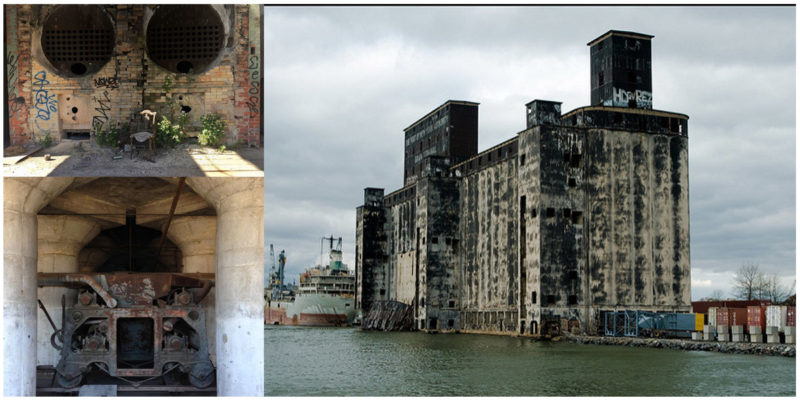The Red Hook Grain Terminal is a grain elevator complex located in Brooklyn, New York City, near to the Gowanus Canal. It was completed in 1922 but because of the fast process of structural improvement in the city, it failed to generate a profit, so was given to the Port Authority of New Jersey and New York in 1944. They closed it for good in 1965 because of financial difficulty. Since then, the building has been abandoned, and there is black mold that overspreads on the silos. The Red Hook elevator was built to serve the Canal System of the city when many other canals were made (524 miles long) which connected a number of bodies of water in the area including Lake Champlain, the Hudson River, and Lake Erie.
This new investment was a big failure because usage of the facility declined very quickly. The old system had started to fail around 1918, operating at only 10% of its capacity. That year, the terminal carried one million bushels of grain, although in 1880 as much as 30 million bushels were brought through. The main reason for this was the deficit of storage place because the New York City’s two-grain elevators were owned by railroads which did not allow the space to barge operators.

The boats just had to wait until another boat came to receive their load. In 1920, it was decided that the city needed a massive grain elevator because it would preserve the investment of the state in the canals. It took the Office of the State 16 months to build the $2.5 million 54-bin concrete grain elevator.

The structure is composed of circular silos, and it was designed to be strong as a bomb shelter. Grain was mechanically picked up from the ships and lifted to the top, from where it was dropped into storage bins. The containers were made vertically, so that gravity could be used release the grain into the ships waiting below.

As mentioned before, the terminal would not be successful as it was intended to be. The day of it’s opening was September 1, 1922, and Governor Nathan L. Miller gave a speech. Three years later, the magazine Engineering News-Record wrote an article about the entire canal calling it an expensive luxury. Some industrial archaeologists remarked that the canals and the terminal were remarkable works of engineering but thought that they were not very useful.

Because of it’s limited usage, the terminal was given to the Port Authority in 1944. It was operated by them until it started to decline at the end of the 1950s. Because of the many more accessible ports that were opened around the city, the terminal was completely deactivated in 1965. In 1990 several plans were made for the terminal, the Authority wanted to sell it or lease it, and the City Department of Sanitation wanted to use the building and its surroundings as a recycling center, but a deal never went through.

It was purchased in 1997 by John Quadrozzi Sr. who incorporated it into the Industrial Park of Gowanus. His son, John Jr. inherited the property and wanted to turn the terminal in the Gowanus Bay Terminal. He and his father had ideas to turn it into a space for commercial use, but that never happened also. So after all the ideas that had been discussed about the place since its closing, the terminal remains abandoned.

Quadrozzi Jr has been trying to open a concrete manufacturing plant since 2007, but approval from the state’s Department of Environmental Conservation has not yet been granted. The demolished building standing alone at the mouth of the Gowanus Canal was used as a location for several music videos including for the song “Term” by Lorde and Klinko’s “Valentine’s Day” sung by David Bowie.
